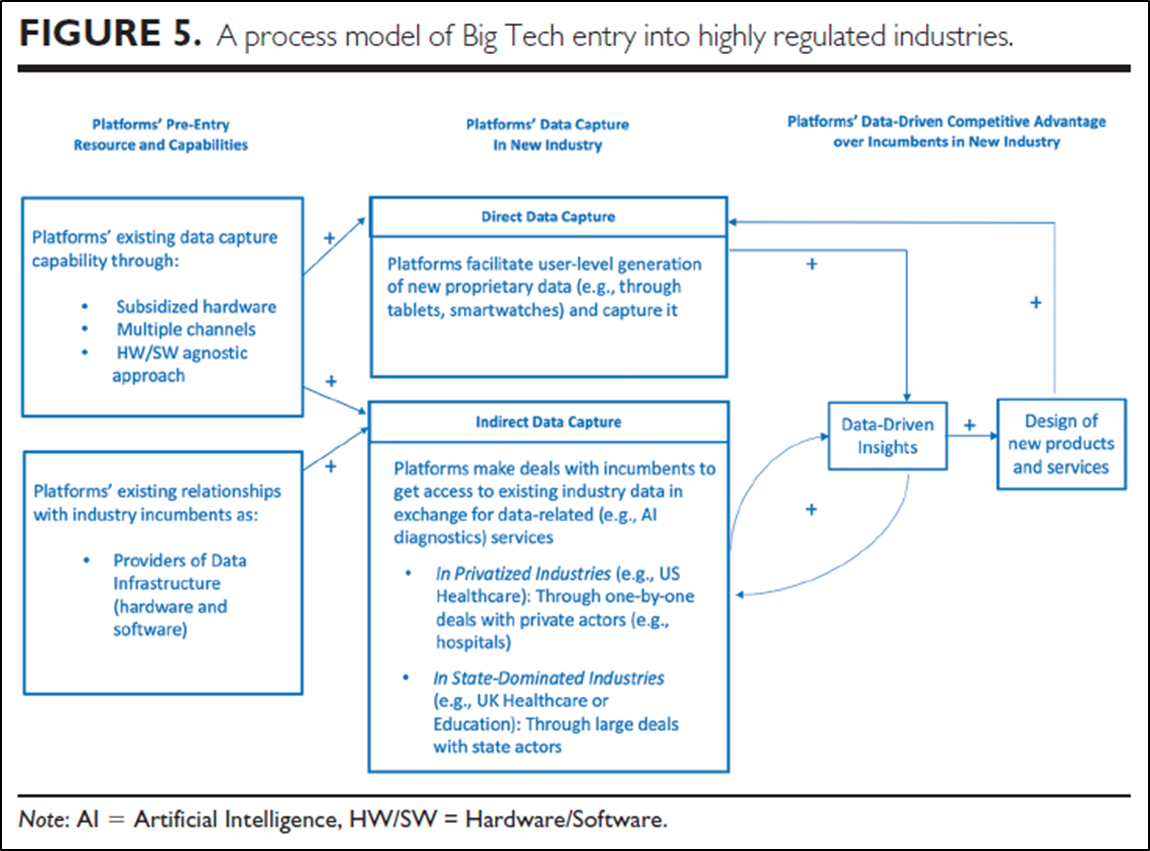Subscribe if you want to be notified of new blog posts. You will receive an email confirming your subscription.
Big Tech’s Platform Playbook in Healthcare: It’s the Data, Stupid

An excellent journal article provides an in-depth exploration of how Big Tech platforms have entered highly regulated industries such as healthcare and education:
“…the crux of platform entry into highly regulated markets is access to sensitive data.”
The article is entitled “Digital Colonization of Highly Regulated Industries: An Analysis of Big Tech Platforms’ Entry into Health Care and Education“. It was published in the California Management Review on May 24, 2022. The 30 page full-text is available as an open-access .pdf.
The authors researched and analyzed the activities of Google (Alphabet), Apple, Facebook (Meta), Amazon and Microsoft in the U.S. and U.K. Their research revealed over 3,500 articles shedding light on how these companies approached healthcare.
I’ll briefly summarize the article, point out its strengths, and comment on how the title of “Digital Colonization” misses the mark.
Big Tech in Healthcare: “Digital Colonization”
“Data sit at the heart of every digital platform. As such, the main logic underpinning the various market segment entries by platforms seems to aim to maximize data collection; enhance data network effects that they have already built across industries to create more value; apply their data analysis capabilities; and take precedence over existing firms while improving products/services for consumers.”
Why did Big Tech’s entry into healthcare require a new playbook? “Highly regulated industries typically have high entry barriers and high operational and compliance costs.” (see Table 1 for a summary of relevant U.S. regulations in healthcare.)
The authors describe the process of Big Tech entry into regulated industries as “digital colonization”. They characterize four stages:
1) Provision of Data Infrastructure Services. Big Techs “typically begin as suppliers of data-infrastructure services to incumbents…healthcare conglomerates typically lack capabilities in data management, they contract out these activities to Big Tech firms as technology service providers, aiming to reduce costs and improve services.”
2) Data Capture (direct and indirect). “Big Techs leverage their existing relationships as well as their data analysis capabilities (which they use to produce data-driven insights) to get access to the data already held by incumbent service providers.”
3) Provision of Data Driven Insights. As Big Tech firms combine the data they captured directly and indirectly, they can provide superior data-driven insights, which can add significant value to incumbent service providers (e.g., through saved lives, better learning outcomes, and lower costs).
4) Design and Commercialization of New Products and Services. “…they may end up competing with their former clients over time.”
Figure 5 summarizes the process of digital colonization of healthcare by Big Tech:

Discussion
The article offers useful perspectives for many healthcare stakeholders: healthcare incumbents, early-stage companies that want to partner with Big Tech and/or incumbents, non-healthcare companies considering entry into healthcare, and regulators/policy makers.
The authors raise questions around the “data-centric approach to platform growth” — issues relating to data privacy, fair competition, and the balance of value creation and value capture.
A major contribution of the article is simply explicating the four stages of the Big Tech healthcare playbook — a sequence that wouldn’t be intuitively obvious to most.
Another contribution of the article is labeling the Big Tech healthcare playbook (i.e., digital colonization) as a unique platform strategy. The authors recognize that this approach is apart from the more typical and forceful “platform envelopment” strategy employed by Big Tech platforms. Platform envelopment is an immediate flanking attack, while digital colonization is more of a long-term infiltration strategy.
Yet one more strength of the article is that the authors examine stakeholder interests from diverse perspectives. They acknowledge that Big Tech can bring unique capabilities to healthcare — capabilities that incumbents don’t have and can’t easily acquire on their own.
That said, my biggest beef with the article is with the use of the term “digital colonization”. The term implies that the invaders inevitably will subjugate the native islanders.
One possible result of digital colonization is Big Tech’s “data-driven competitive advantage over incumbents”. This can occur by changing “the power dynamics…by commoditizing incumbent service providers, turning them into mere complementors while Big Tech firms control the data and become unique providers of critical, data-driven value.”
And while “digital colonization” could turn out badly for incumbents, the term implies a foregone adverse conclusion — one that even the authors offer many useful suggestions on how to avoid.
One last note of caution. The evidence supporting the Big Tech data playbook into healthcare relies on evidence gathered prior to 2021. It’s a rear view mirror perspective documenting Big Tech’s focused interest in data and disinterest in the direct provision of healthcare services, particularly acute care.
At least for some Big Tech (and Big Retail) companies, the view out the windshield is becoming broader than a singular focus on data. For example, Amazon and Walmart recently have begun opening clinics across the U.S. — clinics that provide direct medical care to patients.
Overall, I highly recommend the “Digital Colonization” article for anyone interested in understanding Big Tech’s role in healthcare.
This work is licensed under a Creative Commons Attribution-Share Alike 3.0 Unported License. Feel free to republish this post with attribution.